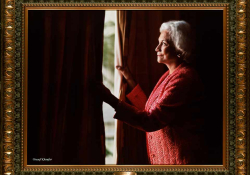The Enduring Impermanence of Jenny Erpenbeck

For Jenny Erpenbeck, nothing lasts forever, not home, not the rituals that connect us to previous generations, not even death. Even her writing style celebrates this impermanence.
In Jenny Erpenbeck’s works, things disappear. People disappear. Knowledge disappears. Even rituals and customs, the practices meant to guard against the erosion of culture by binding us to our past, dissolve over time. Erpenbeck’s oeuvre is thematically complex, historically focused, and materially rich, and yet impermanence—the simple idea that things disappear—is what endures across her works. Who better to write about the eventual disappearance of all things, even those that seem most constant to us, than Jenny Erpenbeck? A young adult when Germany united in 1990, she witnessed the swift dismantling of her state and the erasure of much of her culture as the East was incorporated into the West. For Erpenbeck nothing lasts, not home, not country, not even memory.
Many German authors writing in the twenty-first century cast a historical gaze on the previous one, focalizing that gaze through individual or family narratives. No one does this better than Jenny Erpenbeck. Her debut literary work, the novella Story of the Old Child (1999), garnered rave reviews from critics for its allegory of East Germany as a group home. Story of the Old Child is the parable of a girl found standing alone on a street corner with nothing but the clothes she is wearing and an empty bucket in her hand. A social blank slate, the girl cannot remember who she is or where she is from; she only knows that she is fourteen years old. Unsure of what to do with her, the authorities take her to a home for children, where she quickly finds her place at the bottom of the social ladder because of her physical awkwardness and lack of social skills. She yearns to belong to the social order of the home and eagerly accepts her place at the bottom, the most secure place in any social order because it need not be defended. She knows what exists outside the walls of the school, and whereas others want freedom, she relishes the predictability and order of the school itself. To be sure, there is something unintelligible about this girl, who seems to lack both a sense of self and control over her unwieldy body. It is not until the twist ending of the novella that we learn she harbors a secret: she is not really fourteen years old, but actually thirty. She is a woman who has chosen to retreat to the security and order of an institution for children.
Story of the Old Child draws allusions to German cultural and literary history, particularly to the nineteenth-century foundling Kaspar Hauser and Günter Grass’s Oskar Matzerath, who famously stunted his own growth in the acclaimed novel The Tin Drum. Just as with Grass’s novel, critics have noted the political allegory of Erpenbeck’s story. After the unification of East and West Germany, many former easterners found themselves out of work, their professional credentials revoked, and as a result economically destitute, all without the social structures that had protected them against poverty in the socialist system. The politics and economics of German unification had failed them, and the promise of freedom felt like a cruel trick to many who could not make ends meet in the new capitalist system. By the late 1990s, many wished for a return to the GDR, and critics saw Erpenbeck’s “old child” as an expression of that desire. Other critics saw the girl herself as an allegory of the East, having arrived suddenly on the political scene of the West without understanding the new social order. Like the old child, East Germany was awkward, economically and politically “stunted” in the new system.
In Erpenbeck’s work, the twentieth century is a minefield that can only be survived through luck and coincidence, and this minefield also creates fault lines in intergenerational memory.
Erpenbeck’s two novels that followed, Visitation (2008) and The End of Days (2012), cast a longer gaze on the twentieth century. Visitation depicts a house and plot of land that change ownership three times over the course of the century. Large-scale historical events play out in the microhistory of the house as we follow the fates of four families associated with it. At the opening of the novel, the turn of the twentieth century, the plot of land situated lakeside in Brandenburg is part of a dowry, intended to consolidate wealth among neighbors through marriage. However, when the landholder’s daughter Klara goes mad and cannot marry, her father sells the land to an architect. The transaction leads to Klara’s suicide, a death that symbolizes the passing of an old social system as the new modern capitalist one emerges. The architect builds a house on that land in the 1930s and expands his property by buying the neighboring plot, along with its boathouse and access to the water, at an exploitative price from the Jewish owners who are trying to raise money to flee Germany. We watch as Doris, the child from next door, hides from the Nazis in a dark closet in the Warsaw ghetto but is captured and meets a gruesome death. Her memory of that lake and landscape in Germany is her only comfort as she dies. We watch as the architect’s wife is raped by a Russian officer in the house at the end of the war, and later, we see the architect hide the family’s valuables in the yard before fleeing to the West in the 1950s. We follow the thoughts of a woman whose grandmother was awarded the house by the East German government upon return from exile in Russia during the Nazi period. She must now fight to keep it after German unification, after the architect’s family has placed a restitution claim on it, a fight she ultimately loses.
This last storyline is adapted, famously, from Erpenbeck’s own family history, an expression of mourning at the loss of her grandmother’s lakeside house in Brandenburg, a place of happy childhood memories. The title of the novel, Heimsuchung, translated into English as Visitation by the brilliant Susan Bernofsky, means “visitation” in the sense of “haunting,” but one can also break the German composite noun into “Heim” (home) and “suchen” (to search). Indeed, the house represents both: a longing for a home that no longer exists and also the way in which Germany is haunted by the brutal events of the twentieth century. As readers, we hold our own ghostly position, witnessing these events from a silent distance and with a timeline that far exceeds human scope. The prologue gives a millennia-long history of the slow movement of the icebergs that had formed the hills and lake, and the epilogue recounts the demolition of the house and thus the restoration of the landscape, if ever so briefly. The human activities of the twentieth century are only a small blip in the much larger history of the earth and the forward march of time. This tension between time’s indifference to human activities and the existential urgency of the here-and-now for the individual is something Erpenbeck achieves through panoramic shifts in perspective and a play on distance and zoom.
In the novel that followed, The End of Days, the twentieth century is presented from a very different point of view than in Visitation. Instead of maintaining an intense focus on one place, The End of Days follows a central character who is forced to migrate repeatedly over the course of the century. The protagonist is a woman of eastern European Jewish heritage, and thus the novel frames the events of the twentieth century through the specific hardships and challenges that Jewish women have faced. She experiences varying degrees of social acceptance according to the particular setting of her life—Polish Galicia at the turn of the century, Vienna during the rise of fascism, Russia during the Nazi era, East Germany in the postwar period, and, finally, Berlin after unification—which underscores the precarious position of those on the social margins. While in Visitation the reader feels a ghostly distance to the events of the novel, The End of Days draws the reader in, presenting the traumas of the twentieth century through an intimate closeness with the novel’s characters.
Not only place but also time has a unique meaning in this novel. The End of Days proposes five different versions of the life and death of the central character, a girl/woman who remains unnamed until the end of the novel. Book 1 centers on the mourning of a family whose eight-month-old infant has died in its sleep, and each of the following books of the novel is preceded by an intermezzo that proposes a “what if” scenario that reverses death and extends the life of the child. In book 2, the baby has grown into a girl who experiences starvation and cold in Vienna in the aftermath of World War I and whose need motivates her to become politically active. She dies, however, by suicide with her lover. In book 3, she has become a revolutionary young Communist who moves to Ufa and then Moscow and begins writing for a German-language journal. When she comes under suspicion of being a Trotskyite, however, she is arrested and killed in a prison camp. In book 4, she becomes a celebrated author who has immigrated to East Germany to help shape the cultural consciousness of the new Communist state but dies by pure accident, falling down a flight of stairs. In book 5, she has grown into an elderly woman who experiences the postunification era in a retirement home with others of her generation, whose stories of the German twentieth century go unheard because of mental decline, death, and the lack of mindfulness among the younger generation to ask questions.
Erpenbeck’s uniqueness lies in her experimentation with form, but also in the way she conceptualizes time. It is both cyclical and linear, erratic in both pace and direction.
In Erpenbeck’s work, the twentieth century is a minefield that can only be survived through luck and coincidence, and this minefield also creates fault lines in intergenerational memory. As the narrative takes different turns according to the “what if” scenarios proposed between each book, certain bits of information, rituals, and family stories get passed on to subsequent chapters while others disappear. Continuity, it seems, exists best in material artifacts, family heirlooms. However, the meaning of these artifacts is lost when later generations are unable to recognize them.
Erpenbeck’s uniqueness lies in her experimentation with form, but also in the way she conceptualizes time. It is both cyclical and linear, erratic in both pace and direction. In Visitation, the only character consistently associated with the house is the gardener, a character with a mythic quality about him. Nobody knows where he came from or for how long he has been there. Year after year he plants, weeds, removes trees, adds hedges, performing the seasonal labor of manicuring nature for those who inhabit the house. He appears again and again in the intermezzos between chapters and thus breaks up the forward march of time in the novel with his cyclical work. In The End of Days, time is not only linear, in that it chronicles the twentieth century, and cyclical, in that life cycles repeat across generations; it is also reversible, as the protagonist is repeatedly brought back to life. For Erpenbeck, nothing lasts forever, not home, not the rituals that connect us to previous generations, not even death. Even her writing style celebrates this impermanence. It has a musical quality to it. It is rhythmic and cyclical; leitmotifs repeat not only within one work but throughout her oeuvre. There are reverberations: elements that make a strong appearance at the beginning of her novels repeat but diminished ever so slightly each time so that they eventually fade away altogether. And silence for Erpenbeck, as in music, the space between words, is as important as what is said. We pay attention to what isn’t there, what disappears.
But just when we think we can say something definitive about Erpenbeck’s major themes—about the relationship between impermanence, disappearance, and loss in her works—she shifts our perspective again, rendering impermanence optimistic in her latest novel, Go, Went, Gone (2015). Richard, the protagonist, is a recently widowed professor emeritus of classics, and with the loss of his wife and formal end to his work, he now has time on his hands but little direction. He begins to meditate on his own impending death, prompted in part by his view of the nearby lake from his yard, where a man has recently drowned and the body remains unrecovered. As in other texts by Erpenbeck, death is ever-present, just below the surface. At the beginning of Go, Went, Gone, Richard is focused on what has disappeared, but one day new things become visible to him. After arriving home from visiting a friend’s archaeological dig that exposed underground passageways beneath what is now Alexanderplatz, Richard sees on the evening news that African refugees had gathered in front of Berlin’s city hall, on a hunger strike in a desperate attempt to receive assistance from the city. Richard is troubled by the fact that he had failed to see them when he had walked past that location earlier that day. He resolves to learn more, visits them, and soon becomes devoted to helping. He assists some of the refugees in navigating the legal system, gives piano lessons to one, buys land in Ghana for the mother of another (no small purchase for Richard), invites some refugees to live with him and finds housing for others, and even throws them a Christmas party.
As Richard comes to understand the plight of the refugees, hears their horrific migration stories, and struggles to wrap his mind around the bureaucratic system they find themselves in, so do we as readers. Erpenbeck’s novel is the culmination of thorough research, interviews with refugees in Germany, intense study of European migration law, and a reflection of action that Erpenbeck herself has taken to assist refugees, all of which gives us insight into the opaque bureaucratic system of asylum in Europe and the difficult lives of the displaced. Disappearance as a theme gives way to visibility and enlightenment, and, in the acknowledgments section following the novel, Erpenbeck even provides the reader with information on how to donate to organizations that assist refugees.
The twentieth century according to Erpenbeck’s works was an era of loss and displacement, but Go, Went, Gone has the spirit of pragmatic optimism. It is precisely Erpenbeck’s enduring belief in impermanence that informs this measured hopefulness. While impermanence can mean death, loss, and disconnection from traditions, it also harbors the potential for positive change. Having witnessed rapid social change with the dissolution of her own state, Erpenbeck understands just how impermanent institutions are and what a mistake it is to take the entrenched for eternal. And because of her family history, she understands all too well how precarious stability is. Nothing is permanent, not laws, not personal security, not even the borders, political or otherwise, that divide “us” and “them.” With Go, Went, Gone, she shows us that impermanence should inform our way of interacting with the disadvantaged in our world. If we open our eyes and offer what help we can, maybe we can be a force against the kinds of loss and displacement that characterized the twentieth century.
Manhattan, Kansas












